Quasar - Study guides, Class notes & Summaries
Looking for the best study guides, study notes and summaries about Quasar? On this page you'll find 55 study documents about Quasar.
Page 3 out of 55 results
Sort by
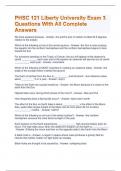
-
PHSC 121 Liberty University Exam 3 Questions With All Complete Answers
- Exam (elaborations) • 8 pages • 2024
-
Available in package deal
-
- $12.99
- + learn more
PHSC 121 Liberty University Exam 3 Questions With All Complete Answers We have seasons because - Answer -the earth's axis of rotation is tilted 23.5 degrees relative to the ecliptic Which of the following is true of the vernal equinox - Answer -the Sun is now crossing the equator into the northern hemisphere and the northern hemisphere begins to face toward the Sun For someone standing on the Tropic of Cancer, the sun will appear at the observer's zenith ___________ each year and at t...
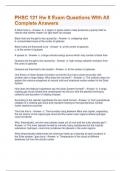
-
PHSC 121 Hw 8 Exam Questions With All Complete Answers
- Exam (elaborations) • 6 pages • 2024
-
Available in package deal
-
- $11.99
- + learn more
PHSC 121 Hw 8 Exam Questions With All Complete Answers A black hole is - Answer -b. a region in space where mass produces a gravity field so intense that neither matter nor light itself can escape Black hols are thought to be caused by - Answer -a. collapsing stars b. concentrated mass at the center of galaxies Black holes are theorized to be - Answer -b. at the center of galaxies c. at the center of quasars A quasar is - Answer -c. a large remote energy source which may contain a ...
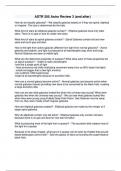
-
ASTR 205 Astro Review 3 (and after)
- Exam (elaborations) • 4 pages • 2023
-
Available in package deal
-
- $10.00
- + learn more
How do we classify galaxies? - We classify galaxies based on if they are spiral, elipitical or irregular. The size is determined be the halo. What kind of stars do elliptical galaxies contain? - Ellipitcal galaxies have only older stars. There is no gas or dust to create new stars. What kind of stars do spiral galaxies contain? - Spiral Galaxies contain old and new stars and much gas and dust. How is the light from active galaxies different from light from normal galaxies? - Active ga...

-
DSST Astronomy Test Prep Questions and Answers
- Exam (elaborations) • 6 pages • 2024
-
Available in package deal
-
- $10.49
- + learn more
terrestrial planet (rocky planet) a planet with a solid surface, that is mainly composed of rock and solid materials gaseous planet (gas giants) a planet that has little to no solid surface and is mostly composed of gases dwarf planet a planet that is too small to be considered a full planet light-year the distance that light travels in one year, roughly 6 trillion miles or 63,000 AU parsec a unit of measurement in astronomy, equals to about 206,000 AU or 3.2 light-years magnitude...

-
LUOA Earth Science Module 10 Questions and Answers 100% Pass
- Exam (elaborations) • 5 pages • 2023
-
Available in package deal
-
- $9.99
- + learn more
LUOA Earth Science Module 10 Questions and Answers 100% Pass Which type of star emits radio waves? Pulsars Dead stars are ________________ , and they no longer undergo nuclear fusion black dwarfs Stars that appear to pulsate but are non-pulsating are called ___________________. eclipsing binary stars Some stars expand and contract giving off varying intensities of brightness. These are _______________. pulsating stars Stars of average size and average temperature are called _______________. ...
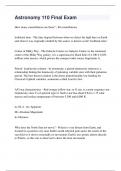
-
Astronomy 110 Final Exam
- Exam (elaborations) • 9 pages • 2024
-
Available in package deal
-
- $15.49
- + learn more
How many constellations are there? - 88 constellations lookback time - The time elapsed between when we detect the light here on Earth and when it was originally emitted by the source, is known as the 'lookback time'. Center of Milky Way - The Galactic Center (or Galactic Centre) is the rotational center of the Milky Way galaxy; it is a supermassive black hole of 4.100 ± 0.034 million solar masses, which powers the compact radio source Sagittarius A. Period- Luminosity relation - In ...
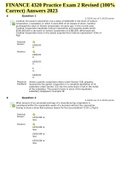
-
FINANCE (FINA4320) Practice Exam 2 Revised (100% Correct) Answers 2023.
- Exam (elaborations) • 19 pages • 2023
-
- $10.99
- + learn more
FINANCE (FINA4320) Practice Exam 2 Revised (100% Correct) Answers 2023. Question 1 3.33333 out of 3.33333 points Cardinal, the parent corporation, has a basis of $440,000 in the stock of Vulture Corporation, a subsidiary in which it owns 90% of all classes of stock. Cardinal purchased the stock in Vulture Corporation 10 years ago. In the current year, Cardinal Corporation liquidates Vulture Corporation and acquires assets worth $500,000 with a tax basis to Vulture Corporation of $380,000....
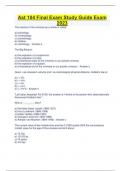
-
Ast 104 Final Exam Study Guide Exam 2023
- Exam (elaborations) • 151 pages • 2023
-
- $14.49
- + learn more
Ast 104 Final Exam Study Guide Exam 2023 The science of the universe as a whole is called: a) proctology. b) universology. c) cosmetology. d) inflation. e) cosmology. - Answer-e The Big Bang is: a) the explosion of a supernova. b) the explosion of a star. c) a theoretical origin of the universe or our pocket universe. d) the explosion of a quasar. e) a theoretical end of the universe or our pocket universe. - Answer-c Given v as recession velocity and r as cosmological p...
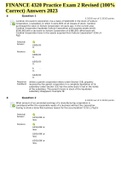
-
FINA 4320 Practice Exam 2 Revised (100% Correct) Answers 2023.
- Exam (elaborations) • 19 pages • 2023
-
- $10.99
- + learn more
FINA 4320 Practice Exam 2 Revised (100% Correct) Answers 2023. Question 1 3.33333 out of 3.33333 points Cardinal, the parent corporation, has a basis of $440,000 in the stock of Vulture Corporation, a subsidiary in which it owns 90% of all classes of stock. Cardinal purchased the stock in Vulture Corporation 10 years ago. In the current year, Cardinal Corporation liquidates Vulture Corporation and acquires assets worth $500,000 with a tax basis to Vulture Corporation of $380,000. What bas...

-
Astronomy Unit 9 Exam - Questions & Answers
- Exam (elaborations) • 6 pages • 2023
- Available in package deal
-
- $10.49
- + learn more
Astronomy Unit 9 Exam - Questions & Answers At position A, small irregular galaxies merge to create ______. a large galaxy with a central black hole At position B, fueling of the supermassive black hole in a massive bulge produces ______. intense quasar activity At position C, mergers of large galaxies produce ______. a radio galaxy At position D, as nuclear fueling and activity winds down, ______ is observed. a normal elliptical galaxy The period-luminosity relation is critical in finding dist...

Did you know that on average a seller on Stuvia earns $82 per month selling study resources? Hmm, hint, hint. Discover all about earning on Stuvia


